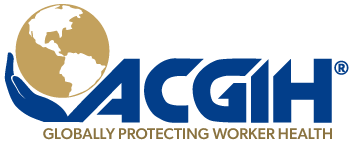- About
-
-

- About
-
ACGIH is a 501(c)(3) charitable scientific organization that advances occupational and environmental health.
-
-
- Subscriptions
-
-

- Subscriptions
-
ACGIH advances the careers of professionals working in the occupational and environmental health, industrial hygiene, and safety communities interested in defining their science.
-
-
- Science
-
-

- Science
-
This section has been established to help educate industry, government, and the public on what TLVs and BEIs are, and how TLVs and BEIs may best be used.
-
-
- Career Development
-
-

- Career Development
-
ACGIH is committed to providing its members and other occupational and environmental health professionals with the training and education they need to excel in their profession.
-
-
- Publications
-
-

- Publications
-
ACGIH has publications in many different areas that fit your needs in your field.
-
- Publications Store
- ACGIH Signature Publications
- Digital Publications
ACGIH Digital Library
If you need to purchase the Digital Library, click here.
If you have purchased and need to access the Digital Library, click here.
-
-
- Foundation
-
-

- Foundation
-
The Foundation for Occupational Health & Safety (FOHS) is a 501(c)(3) corporation fostering the expanded establishment of occupational exposure values throughout the world.
-
-
Webinar – How to Use Haz-Map: A Relational Database of Hazardous Chemicals and Occupational Diseases
The webinar will include this slide show plus a guided tour of the database so that users can more easily find information to assess occupational exposure and disease.
Webinar – Hydrofluoric Acid & Its Toxic Effects on Industrial Workers
This webinar is on the application of HF acid in the oil & gas industry in order to recognize its commercial importance as well as its less known toxic effects on the worker’s health upon its exposure. I will also present regarding how long this toxic material has been in use in the oil & gas industry globally & and ask: is there any alternative to HF acid? If there is, then why is HF acid still preferred even today? I will also share a real HFacid exposed scenario with the audience to examine how HF acid exposure is lethal & even fatal, while medics are not well trained, specifically, to treat HFacid burns & injuries.
Webinar – Health and Safety Issues in Natural Disasters
Natural disasters are further classified by size and impact on people (called catastrophic hazards) and amount of time (called rapid or slow onset hazards). As we discuss the health and safety issues of natural hazards, there are three different consequences of event: Primary Effect – The primary effect of a disaster is the result of the incident itself. Primary effects include wind and rain damage from a hurricane or burned building from a wildfire. Secondary Effect – Secondary effects happen as a result of the primary effect, such as the loss of electricity and running water from a hurricane or fires igniting after an earthquake. Tertiary Effect – Tertiary effects are the long-term impacts that result from the primary effect.
Webinar – Microbial Air and Source Sampling Methods
This webinar will provide information regarding different air and source sampling methods for microbial contaminants in the indoor environment. The talk will cover some of the more common microbial sampling and analytical methods, including culturable, spore traps, bulk sampling, tape lifts, swabs, and vacuum samples, as well as where to collect samples and how to interpret the sample results. In addition, limitations in the various sampling techniques and analyses, particularly spore trap sampling, will be discussed in detail.
Webinar – Worldwide Noise Control Options Database Access – Simplifying Risk Reduction
Most organizations can reduce the risk of Noise induced Hearing Loss in many areas by 50% – 90% at very little (or no) cost (or even at a profit) by making use of the best available engineering noise control measures.
Webinar – OEL Determination APIs and Intermediates in the Pharmaceutical Industry
The webinar will include a description of the approach to determine a quantitative OEL value starting from the data search of reliable toxicological data up to application of safety factors.
Webinar – Engineering Controls to Meet Microgram per Cubic Meter Standards
This webinar will take a look into what types of Engineering Controls are needed for meeting toxic and significantly hazardous airborne dusts such as Lead, Arsenic, Manganese dust, and fumes from industrial processes. It will NOT include controls for radionuclides or other extremely toxic materials.
Webinar – Introduction of Computational Fluid Dynamics Applied in Industrial Ventilation
This webinar will focus on how Computational Fluid Dynamic (CFD) is used in the field of Industrial Ventilation. We will show how this visual technique can be a powerful tool in ventilation design and in troubleshooting Industrial Ventilation systems.
Webinar – A Process Management Approach to Control of Health Hazards from Handheld Power Tools
Powered hand tools have proven essential to industrial operations since their development in the 1880s, but also create exposures to a range of risk factors including hand-arm vibration, noise, ergonomic and mechanical hazards.
Webinar – Beryllium Exposure Risks and Lessons Learned in the US
The human body works in mysterious ways. For those who are genetically susceptible, their body identifies beryllium as a foreign invader resulting first in a sensitization reaction from skin exposure, and then a lung disease called Chronic Beryllium Disease or CBD from inhalation exposure. While the immune response is still not fully understood, this webinar teaches how the body’s immune system overreacts to beryllium particulate by failing to remove it, leaving dead immune cells in the lung resulting in irreparable damage.




